Uterus
#65 Uterus, Human Pre-ovulatory or Proliferative State, H&E
 Identify the specialized uterine mucosa (endometrium) and the muscularis (myometrium). The endometrium is characterized by its cyclic changes under the influence of ovarian hormones. It is important to understand the interrelationships among the pituitary, ovary and uterus during different stages of the menstrual cycle. The proliferative stage follows menstruation and is characterized by the repair of the endometrium and the proliferation of relatively straight, tubular uterine glands. Note the rather dense, cellular appearance of the endometrial stroma (region between glands) at this stage. Coiled endometrial arterioles are not readily evident during the proliferative stage.
Identify the specialized uterine mucosa (endometrium) and the muscularis (myometrium). The endometrium is characterized by its cyclic changes under the influence of ovarian hormones. It is important to understand the interrelationships among the pituitary, ovary and uterus during different stages of the menstrual cycle. The proliferative stage follows menstruation and is characterized by the repair of the endometrium and the proliferation of relatively straight, tubular uterine glands. Note the rather dense, cellular appearance of the endometrial stroma (region between glands) at this stage. Coiled endometrial arterioles are not readily evident during the proliferative stage.
What is the primary ovarian hormone stimulating the endometrium during this stage?
#66 Uterus, Human, Secretory or Progravid Stage, H&E
 Note the marked difference in the thickness of the endometrium as compared to that in the proliferative state. There has been a considerable increase in glandular development, characterized by their convoluted and "saw-toothed" appearance in sections. The glands are frequently distended by a lightly acidophilic secretion rich in glycogen and this serves as an important source of nutrients to the developing embryo prior to implantation.
Note the marked difference in the thickness of the endometrium as compared to that in the proliferative state. There has been a considerable increase in glandular development, characterized by their convoluted and "saw-toothed" appearance in sections. The glands are frequently distended by a lightly acidophilic secretion rich in glycogen and this serves as an important source of nutrients to the developing embryo prior to implantation.
Note the coiled arterioles in the endometrium, and be certain that you understand the significance of the arterial supply to the endometrium. Distinguish between the compact, spongy, and basal zones (stratum basale) of the endometrium. Note: the compact and spongy zones together make up the stratum functionale (the decidua).
What is the dominant ovarian structure during the secretory stage? Which ovarian hormone is necessary for the maintenance of the secretory stage of the endometrium? Which zones of the endometrium may be lost during menstruation? Be certain that you understand the endocrinological and histological basis for menstruation.

